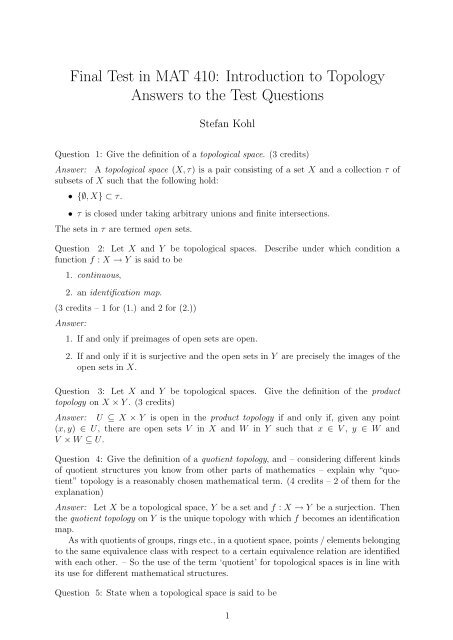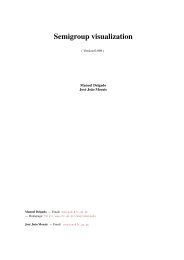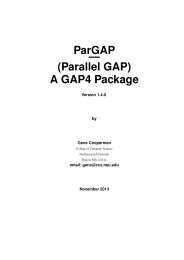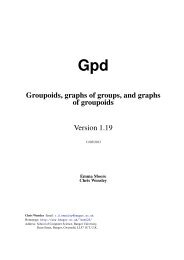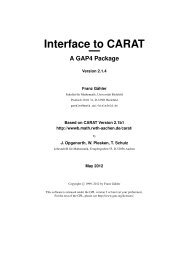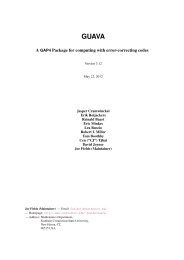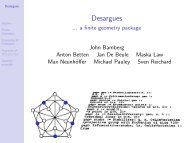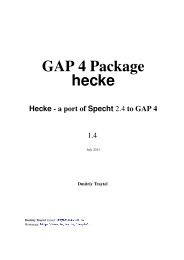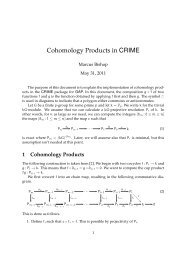Final Test in MAT 410: Introduction to Topology Answers to the ... - Gap
Final Test in MAT 410: Introduction to Topology Answers to the ... - Gap
Final Test in MAT 410: Introduction to Topology Answers to the ... - Gap
Create successful ePaper yourself
Turn your PDF publications into a flip-book with our unique Google optimized e-Paper software.
<strong>F<strong>in</strong>al</strong> <strong>Test</strong> <strong>in</strong> <strong>MAT</strong> <strong>410</strong>: <strong>Introduction</strong> <strong>to</strong> <strong>Topology</strong><br />
<strong>Answers</strong> <strong>to</strong> <strong>the</strong> <strong>Test</strong> Questions<br />
Stefan Kohl<br />
Question 1: Give <strong>the</strong> def<strong>in</strong>ition of a <strong>to</strong>pological space. (3 credits)<br />
Answer: A <strong>to</strong>pological space (X, τ) is a pair consist<strong>in</strong>g of a set X and a collection τ of<br />
subsets of X such that <strong>the</strong> follow<strong>in</strong>g hold:<br />
• {∅, X} ⊂ τ.<br />
• τ is closed under tak<strong>in</strong>g arbitrary unions and f<strong>in</strong>ite <strong>in</strong>tersections.<br />
The sets <strong>in</strong> τ are termed open sets.<br />
Question 2: Let X and Y be <strong>to</strong>pological spaces. Describe under which condition a<br />
function f : X → Y is said <strong>to</strong> be<br />
1. cont<strong>in</strong>uous,<br />
2. an identification map.<br />
(3 credits – 1 for (1.) and 2 for (2.))<br />
Answer:<br />
1. If and only if preimages of open sets are open.<br />
2. If and only if it is surjective and <strong>the</strong> open sets <strong>in</strong> Y are precisely <strong>the</strong> images of <strong>the</strong><br />
open sets <strong>in</strong> X.<br />
Question 3: Let X and Y be <strong>to</strong>pological spaces. Give <strong>the</strong> def<strong>in</strong>ition of <strong>the</strong> product<br />
<strong>to</strong>pology on X × Y . (3 credits)<br />
Answer: U ⊆ X × Y is open <strong>in</strong> <strong>the</strong> product <strong>to</strong>pology if and only if, given any po<strong>in</strong>t<br />
(x, y) ∈ U, <strong>the</strong>re are open sets V <strong>in</strong> X and W <strong>in</strong> Y such that x ∈ V , y ∈ W and<br />
V × W ⊆ U.<br />
Question 4: Give <strong>the</strong> def<strong>in</strong>ition of a quotient <strong>to</strong>pology, and – consider<strong>in</strong>g different k<strong>in</strong>ds<br />
of quotient structures you know from o<strong>the</strong>r parts of ma<strong>the</strong>matics – expla<strong>in</strong> why “quotient”<br />
<strong>to</strong>pology is a reasonably chosen ma<strong>the</strong>matical term. (4 credits – 2 of <strong>the</strong>m for <strong>the</strong><br />
explanation)<br />
Answer: Let X be a <strong>to</strong>pological space, Y be a set and f : X → Y be a surjection. Then<br />
<strong>the</strong> quotient <strong>to</strong>pology on Y is <strong>the</strong> unique <strong>to</strong>pology with which f becomes an identification<br />
map.<br />
As with quotients of groups, r<strong>in</strong>gs etc., <strong>in</strong> a quotient space, po<strong>in</strong>ts / elements belong<strong>in</strong>g<br />
<strong>to</strong> <strong>the</strong> same equivalence class with respect <strong>to</strong> a certa<strong>in</strong> equivalence relation are identified<br />
with each o<strong>the</strong>r. – So <strong>the</strong> use of <strong>the</strong> term ‘quotient’ for <strong>to</strong>pological spaces is <strong>in</strong> l<strong>in</strong>e with<br />
its use for different ma<strong>the</strong>matical structures.<br />
Question 5: State when a <strong>to</strong>pological space is said <strong>to</strong> be<br />
1
1. compact,<br />
2. connected.<br />
(4 credits)<br />
Answer: A <strong>to</strong>pological space is said <strong>to</strong> be<br />
1. compact if every open cover possesses a f<strong>in</strong>ite subcover, and<br />
2. connected if it admits no nontrivial partition <strong>in</strong><strong>to</strong> open sets.<br />
Question 6: Give <strong>the</strong> def<strong>in</strong>ition of <strong>the</strong> diameter of a subset of a metric space. (2 credits)<br />
Answer:<br />
A × A}.<br />
The diameter of a subset A of a metric space (X, d) is sup{d(x, y) | (x, y) ∈<br />
Question 7: What is <strong>the</strong> difference between <strong>the</strong> Kle<strong>in</strong> bottle and <strong>the</strong> <strong>to</strong>rus? – Expla<strong>in</strong>.<br />
(3 credits)<br />
Answer: The <strong>to</strong>rus is an oriented surface, and it can be embedded without self-<strong>in</strong>tersection<br />
<strong>in</strong><strong>to</strong> R 3 . The Kle<strong>in</strong> bottle is a non-oriented surface which cannot be embedded without<br />
self-<strong>in</strong>tersection <strong>in</strong><strong>to</strong> R 3 .<br />
Question 8: Let R 2 be endowed with <strong>the</strong> usual <strong>to</strong>pology. Ei<strong>the</strong>r prove or disprove that<br />
[0, 1[×]0, 1[ and [0, 1[×[0, 1] are homeomorphic subspaces of R 2 . (8 credits)<br />
Answer: A nice proof (with illustrations, which I don’t want <strong>to</strong> copy here) that <strong>the</strong>y are<br />
homeomorphic can be found at<br />
http://www-his<strong>to</strong>ry.mcs.st-and.ac.uk/ john/MT4522/Solutions/S6.7.html<br />
For gett<strong>in</strong>g <strong>the</strong> credits, you were supposed <strong>to</strong> show that you have unders<strong>to</strong>od <strong>in</strong><br />
pr<strong>in</strong>ciple <strong>in</strong> what way a homeomorphism can map [0, 1[×]0, 1[ <strong>to</strong> [0, 1[×[0, 1].<br />
Explicitly determ<strong>in</strong><strong>in</strong>g an homeomorphism would be <strong>to</strong>o time-consum<strong>in</strong>g for an <strong>in</strong>class<br />
exam<strong>in</strong>ation, and was <strong>the</strong>refore not required for gett<strong>in</strong>g <strong>the</strong> full number of credits.<br />
One possibility <strong>to</strong> construct one is <strong>to</strong> partition source and range <strong>in</strong> a suitable way <strong>in</strong><strong>to</strong> 6<br />
triangles, each, and <strong>to</strong> use l<strong>in</strong>ear algebra <strong>to</strong> f<strong>in</strong>d 6 aff<strong>in</strong>e mapp<strong>in</strong>gs which map <strong>the</strong> triangles<br />
of <strong>the</strong> source <strong>to</strong> <strong>the</strong> correspond<strong>in</strong>g triangles of <strong>the</strong> range. This requires sett<strong>in</strong>g up and<br />
solv<strong>in</strong>g 6 systems of 6 l<strong>in</strong>ear equations, each. Of course <strong>the</strong>re are many o<strong>the</strong>r ways <strong>to</strong><br />
construct such homeomorphisms.<br />
Question 9: Let R 3 be endowed with <strong>the</strong> usual <strong>to</strong>pology, and let<br />
1. A := {(x, y, z) ∈ R 3 | xyz = 0},<br />
2. B := {(x, y, z) ∈ R 3 | xyz = 1},<br />
3. C := {(x, y, z) ∈ R 3 | x 2 + y 2 + z 2 = 0},<br />
4. D := {(x, y, z) ∈ R 3 | x 2 + y 2 + z 2 = 1} and<br />
5. E := {(x, y, z) ∈ R 3 | |x| + |y| + |z| ∈ Q}<br />
be endowed with <strong>the</strong> respective subspace <strong>to</strong>pologies. F<strong>in</strong>d out which of <strong>the</strong> <strong>to</strong>pological<br />
spaces A, B, C, D and E are homeomorphic (if any), and which are not. – Proofs required<br />
(no credits without arguments). (10 credits)<br />
Answer:<br />
2
1. A is <strong>the</strong> union of <strong>the</strong> planes x = 0, y = 0 and z = 0, so it is <strong>in</strong>f<strong>in</strong>ite, connected and<br />
unbounded (i.e. not compact).<br />
2. B is <strong>in</strong>f<strong>in</strong>ite, unbounded (i.e. not compact) and has 4 connected components (<strong>to</strong><br />
get xyz positive, ei<strong>the</strong>r all three variables need <strong>to</strong> be positive or exactly two of <strong>the</strong>m<br />
need <strong>to</strong> be negative – and none of <strong>the</strong>m may be 0).<br />
3. C = {(0, 0, 0)} is f<strong>in</strong>ite.<br />
4. D is <strong>the</strong> unit sphere about <strong>the</strong> orig<strong>in</strong>, and hence <strong>in</strong>f<strong>in</strong>ite, connected, closed and<br />
bounded (i.e. compact).<br />
5. E has <strong>in</strong>f<strong>in</strong>itely many connected components – one for each positive rational number.<br />
S<strong>in</strong>ce card<strong>in</strong>ality, compactness and number of connected components are <strong>in</strong>variant under<br />
homeomorphism, all five sets are pairwise non-homeomorphic.<br />
Question 10: F<strong>in</strong>d out which of <strong>the</strong> follow<strong>in</strong>g 20 assertions are true and which are false<br />
(only true/false answers – correct answer: 1 credit, no answer: 0 credits, wrong or unclear<br />
answer: -1 credit, 0 credits <strong>in</strong> <strong>to</strong>tal; answers must be marked by an ‘X’ <strong>in</strong> <strong>the</strong> box after<br />
ei<strong>the</strong>r ‘true’ or ‘false’):<br />
1. For every n ∈ N <strong>the</strong>re is a <strong>to</strong>pological space with n po<strong>in</strong>ts.<br />
true ( X ) false ( )<br />
Just take {1, . . . , n} with <strong>the</strong> trivial <strong>to</strong>pology.<br />
2. Given n ∈ N, up <strong>to</strong> homeomorphism <strong>the</strong>re are exactly 5 · (2 n + 2 n−1 ) − 1 <strong>to</strong>pological<br />
spaces with n po<strong>in</strong>ts.<br />
true ( ) false ( X )<br />
Counterexample: There is only one possible <strong>to</strong>pology on a 1-element set – not 14.<br />
3. Every metric space can also be seen as a <strong>to</strong>pological space.<br />
true ( X ) false ( )<br />
Topological spaces are a generalization of metric spaces – see script.<br />
4. Given any <strong>to</strong>pological space X, one obta<strong>in</strong>s ano<strong>the</strong>r <strong>to</strong>pological space C(X) with<br />
<strong>the</strong> same po<strong>in</strong>ts as X – <strong>the</strong> so-called complement space of X – by lett<strong>in</strong>g <strong>the</strong> open<br />
sets <strong>in</strong> C(X) be <strong>the</strong> sets which are closed <strong>in</strong> X, and <strong>the</strong> closed sets <strong>in</strong> C(X) be <strong>the</strong><br />
sets which are open <strong>in</strong> X.<br />
true ( ) false ( X )<br />
For example <strong>in</strong> R with <strong>the</strong> usual <strong>to</strong>pology, one-po<strong>in</strong>t sets are closed. So s<strong>in</strong>ce<br />
arbitrary unions of open sets are open, <strong>in</strong> C(R) every set must be open – but <strong>in</strong> R<br />
not every set is closed. – Contradiction.<br />
5. There are <strong>to</strong>pological spaces with countably many po<strong>in</strong>ts, which have uncountably<br />
many open sets.<br />
true ( X ) false ( )<br />
Example: countable set with <strong>the</strong> discrete <strong>to</strong>pology.<br />
6. The number of po<strong>in</strong>ts of a f<strong>in</strong>ite Hausdorff space is always a prime power.<br />
true ( ) false ( X )<br />
Counterexample: 6-element set with <strong>the</strong> discrete <strong>to</strong>pology. – This is a Hausdorff<br />
space whose number of po<strong>in</strong>ts is not a prime power.<br />
3
7. R with <strong>the</strong> usual <strong>to</strong>pology is a compact <strong>to</strong>pological space.<br />
true ( ) false ( X )<br />
The open cover R = ∪ n∈Z ]n, n + 2[ does not possess a f<strong>in</strong>ite subcover.<br />
8. R with <strong>the</strong> Zariski <strong>to</strong>pology is a compact <strong>to</strong>pological space.<br />
true ( X ) false ( )<br />
See Exercise 29.<br />
9. R with <strong>the</strong> usual <strong>to</strong>pology is a connected <strong>to</strong>pological space.<br />
true ( X ) false ( )<br />
The only sets <strong>in</strong> R which are both open and closed are ∅ and R.<br />
10. R with <strong>the</strong> Zariski <strong>to</strong>pology is a connected <strong>to</strong>pological space.<br />
true ( X ) false ( )<br />
No subset of R is both f<strong>in</strong>ite and has a f<strong>in</strong>ite complement – so <strong>the</strong> above holds also<br />
here.<br />
11. All Hausdorff spaces with countably many po<strong>in</strong>ts are compact.<br />
true ( ) false ( X )<br />
Counterexample: Z with <strong>the</strong> discrete <strong>to</strong>pology. – Then <strong>the</strong> open cover consist<strong>in</strong>g of<br />
<strong>the</strong> 1-element subsets possesses no f<strong>in</strong>ite subcover.<br />
12. In a compact metric space, every sequence of po<strong>in</strong>ts has a convergent subsequence.<br />
true ( X ) false ( )<br />
See Theorem 7.22 <strong>in</strong> <strong>the</strong> script.<br />
13. F<strong>in</strong>ite <strong>to</strong>pological spaces are always connected.<br />
true ( ) false ( X )<br />
Counterexample: discrete <strong>to</strong>pological space with at least 2 po<strong>in</strong>ts.<br />
14. F<strong>in</strong>ite <strong>to</strong>pological spaces are never connected.<br />
true ( ) false ( X )<br />
Counterexample: any f<strong>in</strong>ite set with <strong>the</strong> trivial <strong>to</strong>pology.<br />
15. There are Hausdorff spaces which are <strong>to</strong>tally disconnected.<br />
true ( X ) false ( )<br />
Example: discrete <strong>to</strong>pological spaces.<br />
16. Let Z be endowed with <strong>the</strong> <strong>to</strong>pology where <strong>the</strong> open sets are <strong>the</strong> set-<strong>the</strong>oretic unions<br />
of residue classes. Then f : Z → Z, n ↦→ n + (−1) n is an homeomorphism.<br />
true ( X ) false ( )<br />
The function f maps unions of residue classes <strong>to</strong> unions of residue classes, so it is<br />
an homeomorphism.<br />
17. The set S ⊂ R n (n ∈ N) of zeros of a polynomial P ∈ R[x 1 , . . . , x n ] is always<br />
bounded, and its diameter is bounded above by <strong>the</strong> product of <strong>the</strong> coefficients of P .<br />
true ( ) false ( X )<br />
Counterexample: <strong>the</strong> set of zeros of <strong>the</strong> zero polynomial is R n , and hence unbounded.<br />
18. Let A be a bounded subset of R 3 , and let B ⊂ R 3 be a superset of A such that<br />
B \ A is f<strong>in</strong>ite. Then <strong>the</strong> diameter of B is <strong>the</strong> same as <strong>the</strong> diameter of A.<br />
true ( ) false ( X )<br />
B may conta<strong>in</strong> a po<strong>in</strong>t ‘far away’ from A.<br />
4
19. The diameter of <strong>the</strong> closure of a subset A ⊂ R is always <strong>the</strong> same as <strong>the</strong> diameter<br />
of A itself.<br />
true ( X ) false ( )<br />
See Lemma 7.19 <strong>in</strong> <strong>the</strong> script.<br />
20. The diameter of <strong>the</strong> <strong>in</strong>terior of a subset A ⊂ R is always <strong>the</strong> same as <strong>the</strong> diameter<br />
of A itself.<br />
true ( ) false ( X )<br />
Counterexample: A = Q ∩ [0, 1].<br />
(20 credits)<br />
5


